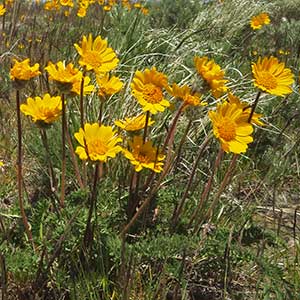Balsamorhiza macrophylla
Balsamorhiza hookeri
cutleaf balsamroot, Idaho balsamroot, large-leaf balsamroot
hairy balsamroot, hare's head balsamroot, Hooker's balsam root
green, ovate to lanceolate, 20–50+ × 8–15 cm (pinnatifid, lobes lanceolate, 20–80+ × 10–40 mm, entire or ± dentate), bases ± cuneate, ultimate margins usually entire (plane or weakly revolute, ciliate), apices obtuse to acute, faces scabrous or piloso-hirtellous to pilose (at least abaxial usually gland-dotted as well).
blades usually gray-green, narrowly to broadly lanceolate or ovate, (8–)20–30(–40) × 2–15 cm (1–2-pinnatifid, primary lobes oblong or lanceolate to linear, 5–100 × 0.5–15 mm, secondary lobes usually ± linear, spreading), bases ± truncate to broadly cuneate, ultimate margins usually entire (plane or revolute, ciliate or not), apices obtuse to acute, faces hirsute, sericeous, or strigose (and gland-dotted or finely stipitate-glandular).
± hemispheric, 20–30 mm diam.
campanulate to hemispheric, 15–30 mm diam.
35–50+ mm.
15–30(–45) mm.
lance-ovate or lanceolate to lance-linear, 12–30(–40) mm, equaling or surpassing inner (margins ciliate), apices acute to attenuate.
ovate-lanceolate to lanceolate, 10–24+ mm, seldom surpassing inner, apices acuminate to attenuate (margins usually ciliate).
usually borne singly.
borne singly.
= 100 ± 2.
= 38.
Balsamorhiza macrophylla
Balsamorhiza hookeri
Balsamorhiza macrophylla is a high polyploid; it occurs sympatrically with B. sagittata. It evidently arose from hybridization between B. sagittata and B. hispidula. Balsamorhiza macrophylla has the multi-branched caudices and massive taproots of the former, and the leaf dissection of the latter. No hybrids with other species are known. Presumably, the high-polyploid chromosome complement precludes interbreeding. Plants of var. idahoensis are smaller, are known only from southwestern Idaho and northeastern Utah, and differ from var. macrophylla by being pilose, with strongly shaggy-pilose involucres. More study may determine that var. idahoensis merits specific rank. The Utah populations are not well understood and deserve attention.
(Discussion copyrighted by Flora of North America; reprinted with permission.)
At one time or another, most species of subg. Balsamorhiza have been synonymized under B. hookeri. Nevertheless, a number of taxa are justifiably segregated as species by their morphologic differences and geographic restrictions. One might logically choose either of two taxonomies: recognizing only two species in the entire genus, one representing subg. Artorhiza and the other subg. Balsamorhiza, or recognizing each slightly differing population as a species. Either course results in an unsatisfactory classification. The present classification is a compromise. A knotty problem persists. A central cluster of populations from eastern Washington to southeastern California display a number of minor and locally discrete morphologies. They tend to be less isolated from each other than are the peripheral populations, although some tend to mimic the latter ones in one or more characteristics. Their evolutionary history may be involved with past hybridizations with each other or with species of subg. Artorhiza, gene drift, and polyploidy. At present, it appears impossible to reach a satisfactory classification.
(Discussion copyrighted by Flora of North America; reprinted with permission.)


